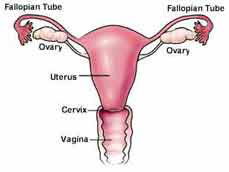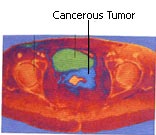Cytogenetic characterization
of tumors of the vulva and vagina evaluated
(Gynecologic Tumors-November
3, 2003)
According to recent research
from Norway, "Neoplasms of the vulva and vagina account for less than 5% of
all female genital tract cancers. Squamous cell carcinoma (SCC) represents more than
70% of the cases in both locales, followed by melanoma, basal cell
carcinoma, Paget's disease, and other carcinoma subtypes.
genital tract cancers. Squamous cell carcinoma (SCC) represents more than
70% of the cases in both locales, followed by melanoma, basal cell
carcinoma, Paget's disease, and other carcinoma subtypes.
"Until recently, only few cases had been analyzed by chromosome banding
techniques and karyotyped, and also the number subjected to molecular
cytogenetic analysis remains low. To understand better the genetic changes
harbored by the neoplastic cells in cancer of the vulva and vagina, we
analyzed cytogenetically 51 such tumors, finding karyotypic abnormalities in
37," wrote F. Micci and colleagues, Norwegian Radium Hospital, Department of
Cancer Genetics.
"All tumors were analyzed by G-banding, sometimes supplemented by multicolor
fluorescence in situ hybridization, and a subset of tumors was also analyzed
by comparative genomic hybridization. The two cytogenetically abnormal cases
of Paget's disease both had two clones, one with gain of chromosome 7 as the
sole change, the other with loss of the X chromosome among, in one case,
other aberrations," the researchers wrote.

"The four cytogenetically abnormal malignant melanomas (three of the vulva,
one of the vagina) presented complex karyotypes with aberrations involving
different chromosomes but most often chromosome 1, specifically 1p12-q41,"
the researchers stated.
"In the 31 cytogenetically abnormal SCCs, different clonal karyotypic
abnormalities were seen. Intratumor heterogeneity with multiple clones was
observed in 11 cases. The clones were cytogenetically unrelated in eight
tumors but related in three, indicating that in the latter clonal evolution
had taken place from a single malignantly transformed cell," they added.
"The main chromosomal imbalances were gains of, or from, chromosome arms 3q,
5p, 8q, 9q, and 19q, and loss from 11q. Breakpoint clusters were seen in
11q13-23, 2q22-35, and 19q13, as well as in the centromeres and
pericentromeric bands of chromosomes 3, 8, 9, 13, 14, and 22," the
researchers concluded.
Micci and colleagues published their study in Genes Chromosomes & Cancer (Cytogenetic
characterization of tumors of the vulva and vagina. Genes Chromosomes
Cancer, 2003;38(2):137-148).
For additional information, contact S. Heim, Norwegian Radium Hospital,
Department of Cancer Genetics, N-0310 Oslo, Norway.
The information in this article comes under the major subject areas of
Gynecology and Oncology. This article was prepared by Health & Medicine Week
editors from staff and other reports.
ęCopyright 2003, Health &
Medicine Week via NewsRx.com & NewsRx.net